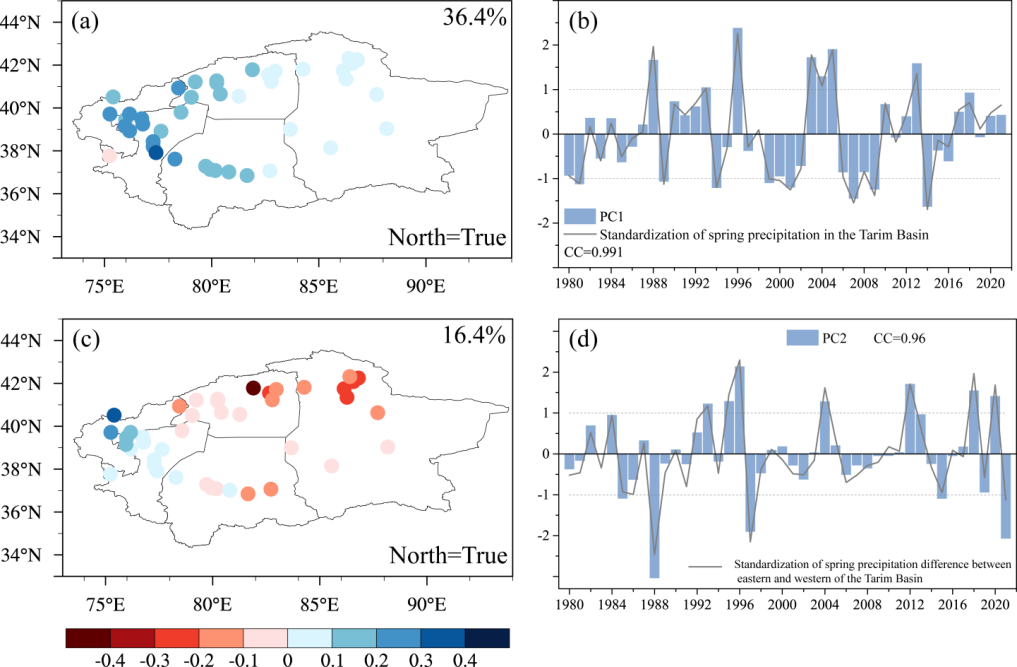
Research Highlight

The Tarim Basin is located in the extreme arid region of northwestern China, where wind-sand disasters are severe and the ecological environment is fragile. In recent years, frequent extreme precipitation events in this region have attracted widespread attention. Therefore, studying the evolution law of precipitation in the Tarim Basin of southern Xinjiang is of great significance for improving the accuracy of regional climate prediction and guiding local agricultural and animal husbandry production, as well as disaster prevention and mitigation.

Fig. The first two spatial modes (a, c) and their corresponding time series (b, d) of spring precipitation by EOF decomposition in the Tarim Basin during 1980–2021 (North = True indicates that the North test was passed)
The Central Asian Climate Research Team of the Institute of Desert Research, based on daily precipitation observation data in the Tarim Basin and ERA5 monthly reanalysis data of circulation fields, used climatological statistical diagnostic methods to explore the modes of spring precipitation anomalies in the Tarim Basin and the characteristics and differences of concurrent atmospheric circulation evolution. The analysis found that spring precipitation anomalies in the Tarim Basin exhibited two independent precipitation modes: the first mode was a basin-wide uniform pattern, and the second mode was an east-west out-of-phase pattern. The atmospheric circulation characteristics causing these spring precipitation anomaly modes in the Tarim Basin showed significant differences. Basin-wide uniform precipitation was influenced by mid-high latitude circulation. In the 500 hPa geopotential height field, it was affected by the negative phase anomaly-related circulation of the North Atlantic Oscillation (NAO), with the Tarim Basin under negative geopotential height anomaly. It received water vapor transport from the mid-latitude Atlantic westerly and Arabian Sea southerly anomalies, which were lifted by the terrain. During the west-more-east-less precipitation pattern, the western (eastern) part of the Tarim Basin was affected by abnormal cyclones (anticyclones), and strong Rossby wave trains were excited in the North Atlantic, splitting into two branches in western Europe, jointly promoting spring precipitation in the Tarim Basin. From the perspective of vertical circulation, the western part of the Tarim Basin was dominated by upward motion, while the eastern part was dominated by downward motion. Affected by abnormal water vapor transport from the southwest and water vapor convergence, favorable water vapor conditions were provided for precipitation. In terms of water vapor 收支 (budget) at each boundary, the net water vapor budget in the Tarim Basin showed an abnormal pattern of "western inflow and eastern outflow", and the atmospheric precipitable water also exhibited an out-of-phase distribution characteristic.
The relevant achievements were published in Atmospheric Research under the title "Dominant spring precipitation anomaly modes and circulation characteristics in the Tarim Basin, Central Asia". The first author of the paper is Research Assistant Dilinuer from the Institute of Desert Research, and the corresponding author is Researcher Yao Junqiang from the Institute of Desert Research. The research was supported by the Xinjiang Natural Science Foundation (2022D01B230, 2022D01D86), the National Natural Science Foundation of China (421710380), and the Guiding Plan Project of Xinjiang Meteorological Bureau (YD202207).
Original information: Dilinuer T., Yao J.Q., Mao W.Y., et al., 2025. Dominant spring precipitation anomaly modes and circulation characteristics in the Tarim Basin, Central Asia. Atmos. Res. 313, 107767.
Article link:https://doi.org/10.1016/j.atmosres.2024.107767

0991-2652429

desert@idm.cn

新疆维吾尔自治区乌鲁木齐市建国路327号


Scan to follow
us on WeChat